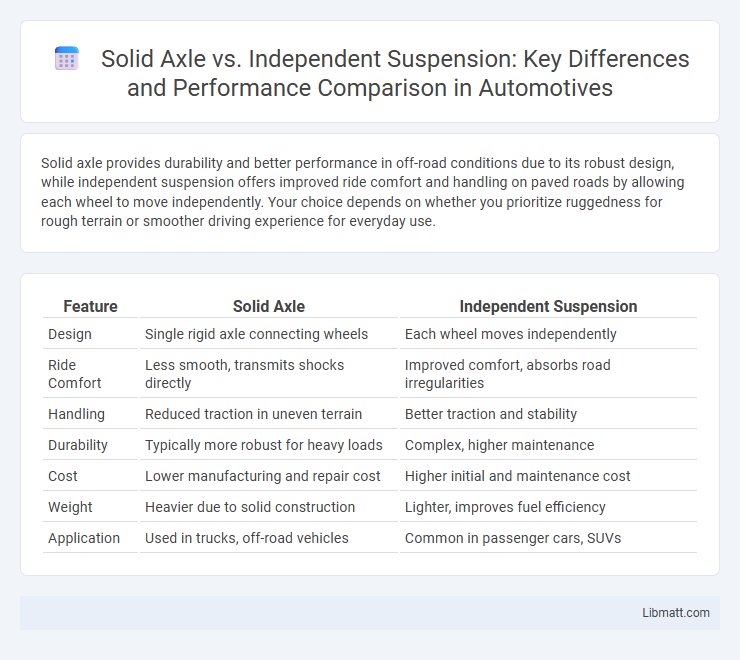Solid axle provides durability and better performance in off-road conditions due to its robust design, while independent suspension offers improved ride comfort and handling on paved roads by allowing each wheel to move independently. Your choice depends on whether you prioritize ruggedness for rough terrain or smoother driving experience for everyday use.
Table of Comparison
| Feature | Solid Axle | Independent Suspension |
|---|---|---|
| Design | Single rigid axle connecting wheels | Each wheel moves independently |
| Ride Comfort | Less smooth, transmits shocks directly | Improved comfort, absorbs road irregularities |
| Handling | Reduced traction in uneven terrain | Better traction and stability |
| Durability | Typically more robust for heavy loads | Complex, higher maintenance |
| Cost | Lower manufacturing and repair cost | Higher initial and maintenance cost |
| Weight | Heavier due to solid construction | Lighter, improves fuel efficiency |
| Application | Used in trucks, off-road vehicles | Common in passenger cars, SUVs |
Introduction to Suspension Systems
Suspension systems play a crucial role in vehicle dynamics by absorbing shocks and maintaining tire contact with the road. Solid axle suspension features a rigid beam connecting both wheels, providing durability and load-bearing strength ideal for off-road and heavy-duty applications. Independent suspension allows each wheel to move independently, enhancing ride comfort and handling precision on varied terrains.
What Is a Solid Axle?
A solid axle, also known as a live axle, is a single rigid shaft connecting the wheels on opposite sides of a vehicle, allowing them to move in unison. This suspension type is commonly used in trucks and off-road vehicles due to its durability and ability to handle heavy loads. When choosing between solid axle and independent suspension, consider your driving needs as a solid axle offers robustness but may sacrifice ride comfort and handling precision.
What Is Independent Suspension?
Independent suspension allows each wheel on the same axle to move independently, enhancing ride comfort and handling by reducing the impact of road irregularities. Unlike solid axles, which connect both wheels rigidly, independent suspension systems provide better traction and stability on uneven surfaces, improving your vehicle's overall performance. This setup is common in modern cars and SUVs, offering a smoother ride and greater flexibility in suspension tuning.
Key Differences Between Solid Axle and Independent Suspension
Solid axle suspension features a single rigid beam connecting both wheels, providing durability and better load-carrying capacity, especially in off-road and heavy-duty vehicles. Independent suspension allows each wheel to move independently, enhancing ride comfort, handling, and traction on uneven surfaces by reducing unsprung weight. Key differences include the impact on vehicle stability, ride quality, and off-road performance, with solid axles favored for rugged terrain and independent suspension preferred for on-road comfort and agility.
Ride Comfort and Handling Comparison
Solid axle suspension offers durability and strength, often found in off-road and heavy-duty vehicles, but it tends to deliver a stiffer ride and less precise handling due to the connected wheel movement. Independent suspension improves ride comfort by allowing each wheel to move independently, enhancing traction and providing better handling, especially on uneven surfaces and curves. For your daily driving needs and smoother ride experience, independent suspension typically offers superior performance in terms of ride comfort and maneuverability.
Off-Road Performance: Solid Axle vs Independent Suspension
Solid axle suspension offers superior durability and articulation, making it ideal for extreme off-road conditions where wheel travel and ground clearance are critical. Independent suspension provides better ride comfort and handling on uneven terrain by allowing each wheel to move independently, reducing body roll and improving traction on varied surfaces. Your choice between solid axle and independent suspension will impact your vehicle's off-road capability based on terrain difficulty and desired driving comfort.
Durability and Maintenance Considerations
Solid axles offer superior durability in heavy-duty applications due to their robust construction and simpler mechanical design, making them less prone to damage under extreme loads and off-road conditions. Independent suspensions require more frequent maintenance because of their complex components, such as control arms and CV joints, which are subject to wear and require regular inspections and replacements. For vehicles operating in rugged environments or carrying heavy loads, the solid axle system minimizes downtime and repair costs, while independent suspension provides better ride comfort at the expense of increased maintenance.
Cost Analysis: Which Suspension Is Cheaper?
Solid axle suspension is generally more cost-effective due to its simpler design, fewer components, and easier maintenance, making it ideal for budget-conscious off-road vehicles. Independent suspension systems, while offering improved ride comfort and handling, involve higher manufacturing and repair costs because of their complex architecture and additional parts like control arms and CV joints. Overall, solid axles provide a lower initial and upkeep cost compared to independent suspensions, often influencing vehicle pricing and long-term maintenance expenses.
Best Applications: When to Choose Each Suspension
Solid axle suspension is ideal for off-road vehicles and heavy-duty trucks where durability and load-bearing capacity are crucial, providing superior ground clearance and strength on rough terrain. Independent suspension suits passenger cars and performance vehicles, offering enhanced ride comfort, better handling, and improved traction on paved roads by allowing each wheel to move independently. Your choice depends on whether you prioritize ruggedness and simplicity or ride quality and maneuverability tailored to specific driving conditions.
Conclusion: Which Suspension System Is Right for You?
Choosing between solid axle and independent suspension depends on your priorities and driving conditions. Solid axles offer durability and superior off-road performance, making them ideal for heavy-duty or rugged terrain use. Independent suspension provides better ride comfort and handling on paved roads, so your decision should balance terrain type and desired driving experience.
Solid Axle vs Independent Suspension Infographic

 libmatt.com
libmatt.com